Your Step-by-Step Guide to Buying Property in Portugal’s Undiscovered North
By Ronan McMahon
Portugal is one of the world’s most popular destinations among vacationers, expats, and real estate investors.
But there is an amazing region of this country that remains overlooked and undervalued.
The stunning towns and cities north of Portugal’s second city of Porto boast incredible soft-sand beaches…rich history and culture…and stunning food and architecture—basically, all the elements that make destinations to the south so appealing.
But they are virtually unknown to foreign tourists, expats, and second home owners. And because of this, prices in these towns and cities are astonishingly affordable.
This is Portugal’s “undiscovered north.”
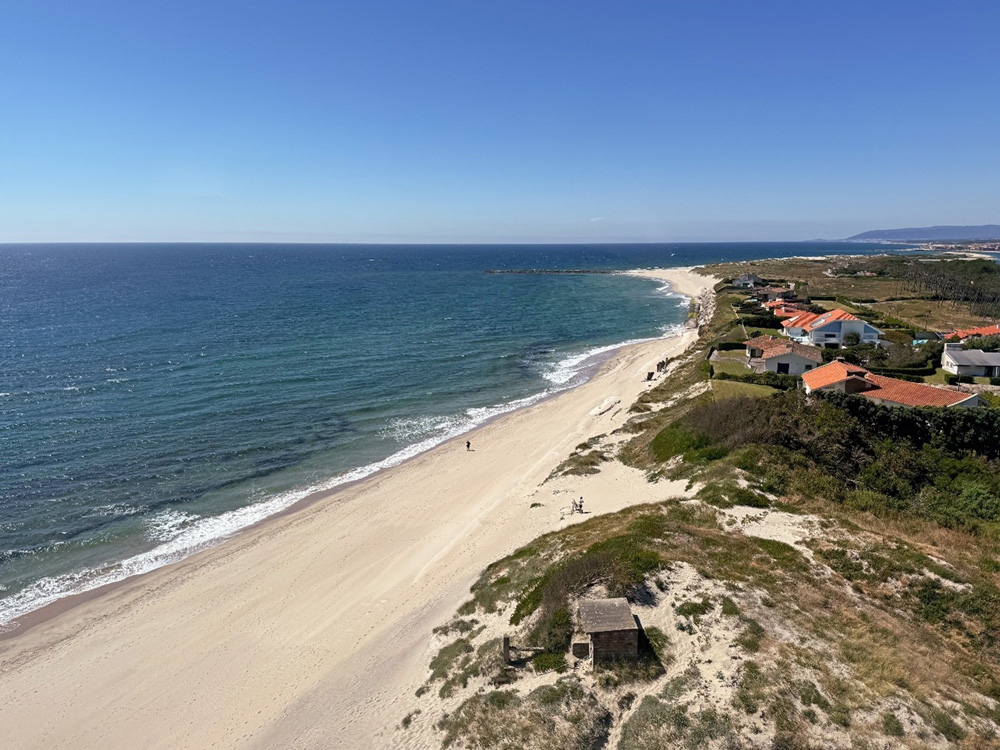
This stunning region flies under the radar today, but very soon, I believe that will change. This region will be discovered. And I anticipate prices will soar. That’s why I’ve just bought a home here (more on that in a moment).
What this means is that, right now, we have a once-in-a-generation opportunity.
It’s as though we have a time machine and can step back to Portugal’s southern Algarve region and Lisbon 30 years ago…or the Silver Coast region 20 years ago…or the city of Porto 10 years ago…before the explosion in tourist numbers and real estate prices in each of those destinations.
Portugal’s “undiscovered north” represents one of the best real estate investment opportunities on Earth.
And the moment is now!
I’ve been repeating this message for well over a year now to my readers. I’ve been screaming it from the rooftops…pounding the table about it…ever since I first scouted the coastal town of Caminha in the far north of Portugal.
Now, I’ve put my money where my mouth is…

As I write, I’ve just completed the purchase of a historic mansion in Caminha.
From my garden—big, shaded and private, with lemon and avocado trees and vines crawling over trellises—I can look across glass-flat water to Spain. Pan to my left and I see waves crashing on a Spanish beach…pan a bit more and I see tides rippling onto a golden-sand Portuguese beach.
Inside, this historic home is immaculate…furnished with original pieces that came from Brazil with the first owners at the end of the 1800s.
For the past nine years, the home had been a Spanish couple’s labor of love. Now they need to move back across the border to Spain. My wife and I are delighted to take stewardship of the house. The place is like a dream and a gift at the same time. It spans around 5,000 square feet. But I got it for around €410,000 ($434,500). That works out as less than $90 per square foot!
This demonstrates the insane value you can find in this part of Portugal.

Over my career as a real estate scout and investor, I’ve completed dozens of real estate purchases across multiple continents. I’ve rarely, if ever, been as excited as I am about this one.
The lifestyle on offer with this home is incredible. There’s the weather, the culture, the beaches, the hiking, the historic town center of Caminha with its restaurants and cafés, the easy access to Spain just across the river…
I’m looking forward to spending lots of time here.
But this home is not simply a lifestyle play…there’s also huge investment potential.
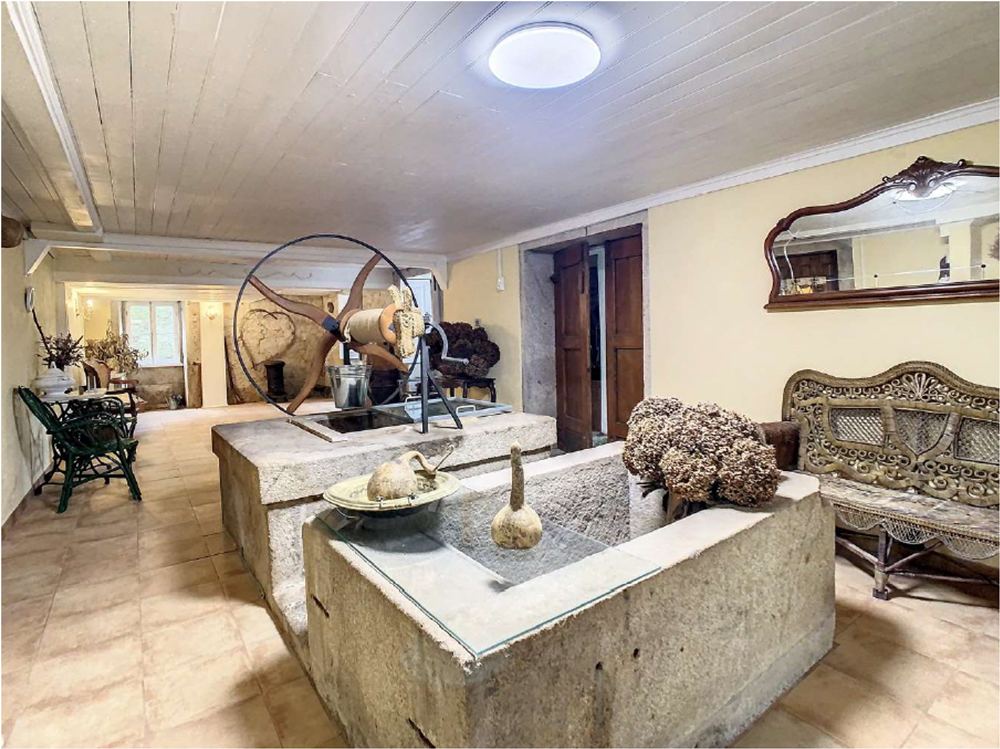
This part of Portugal has stayed off the radar, but now a Path of Progress is moving north. Every time my team and I have returned to scout this region, we’ve seen more historic buildings being restored….more work being done to rejuvenate town centers…more real estate projects aimed at wealthy investors and second home owners…
As I say, I believe this region will be discovered. Yet, right now, we’re still able to buy blue-chip real estate here for crazy-low prices.

That’s why I’ve put together this buyer’s guide.

A Step-by-Step Guide to Buying in Portugal
Step 1: Profile Yourself
Before you do anything, it’s important to sit down and ruthlessly profile yourself. You need to consider what you want to own and why.
To do this, I suggest you get your smartphone out, or open up your computer and type out your answers. Or use a pen and paper. You’re going to interview yourself. And be truthful.
Think about these questions…
Do you prefer mountains or beaches? Are you more of a city person or do you want a smaller town?
Are you purchasing as an investment or buying a vacation home? Is this a place you are going to spend a lot of time or will you visit only occasionally? Are you seeking some income to cover the holding costs of the property? Are you hoping for big increases in capital appreciation or do you just love the view?
You need to be clear from the start what you want to get out of a property—and also how much you are willing to put in.
What is your time worth to you? Your energy? If you’re working 60-hour weeks and are well-paid for it, you don’t have much time. So, buying a renovation project—however profitable it might seem on paper—might not stack up as a good play for you. Buying a turnkey home or condo might be though.
The good news is that whatever your answers to the questions above, there is almost certainly a good real estate deal for you in Portugal’s “undiscovered north.” Something to suit your circumstances.
Over the past several years, my team and I have scouted destinations right across this region and we’ve been impressed by many of the towns we’ve explored.
I decided to own in Caminha because I love the easy access to beaches…the incredible hiking…the upmarket, historic town center. Plus it’s just over an hour’s drive on excellent roads to the major international airport in Porto. So, Caminha was the place for me.
But my team also scouted (and loved!) the city of Viana do Castelo…which you may prefer if you want access to a bigger community. There’s the utterly charming inland river town of Ponte de Lima and the coastal town of Esposende, where you can own true beachfront…
The point is, you have lots of options.
That’s why at this stage of the process, I’d also highly recommend you review our recent scouting reports on this region of Portugal. I’ve included an edited version of those in the Appendix of this report. This will introduce you to some of the key markets here and help you narrow down your choices.
That said, don’t feel pressure at this stage to select a single destination. Narrow down your options to at least two or three you might like…and then plan your scouting trip.
Step 2: Put Boots on the Ground
This region of Portugal isn’t the kind of place where I’d recommend simply calling up a broker and purchasing from overseas. You’ll need to put in the groundwork yourself. And you’ll want to view potential properties in person.
Start by investigating the towns on your shortlist. Understand the different neighborhoods within those towns. Also start researching on Idealista.
This is a listings website (www.idealista.pt/en/) and app you can download from the Google Play Store or Apple App Store. It allows you to see many, but not all, of the available real estate listings in Portugal. It also has a map function that allows you to draw a circle around an area you like and see all the available listings in that area.
This is a great way to narrow your search…
For instance, I identified a narrow coastal strip near Caminha that I really liked. Then, to find my home there, I drew a circle around this area and went through every listing on the market in it.
I also got a sense of pricing in the area by monitoring the listings there over time.
In my case, since I had been to Caminha before, I made a list of the properties I wanted to see prior to arriving in town. Then I reached out to a real estate agent and asked if any of the listings were hers, and if not, could she arrange for me to view the properties.
The agent I used was Ana Valverde from the Bambu agency.
Ana said none of the listings I found belonged to her agency, but that she would still be able to show me all of the homes. That may sound surprising since in many parts of the world agents don’t share listings. But Caminha is a small, close-knit market and she has good relations with the other agents in town.
Step 3: Bid on One or More Homes
Typically, my process is to try and identify three or four properties that meet my requirements. Then I’ll make offers on several.
I’ll be transparent with the sellers that this is my process. And I’ll make it clear that once the first offer is accepted, the other offers are off the table.
I also connect with an attorney at this point in the process. I like to run any offers by my attorney to get their assessment.
In the case of buying my Caminha home, I only made an offer on one home, as this was the only home that met my requirements. The asking price was €440,000.
In a negotiation like this, I don’t like to get into a lengthy back and forth with sellers. I make an assessment of the range that is acceptable to them. You want to get a good deal. But you also don’t want to make a lowball offer that offends the seller and causes them to walk away.
I offered €400,000 and explained that my wife and I were leaving town the next day. If we could shake hands in the next 24 hours, we would have a deal. Creating this sense of urgency is important. I don’t want protracted negotiations. Within a couple of hours, the sellers countered at €410,000 and the deal was done.
Step 4: Getting Financing and Conducting Legal and Engineering Checks
Once your offer is accepted, you can proceed with legal checks and inspections.
I asked my attorney Ricardo to conduct the necessary legal checks and draft the sales contract. In Portugal, either side can draft the contract, but I prefer for it to be drawn up on my side, as I want to retain control.
I also hired an engineer to go out and do a full engineering report and risk assessment.
Getting an engineer’s inspection is not necessarily the norm in Portugal, and it’s not required by the mortgage provider to get financing, but I would advise you to do this. This is particularly important when buying a historic property.
My engineer is Nelson Bento Pereira from the Houselab engineering office. My team have completed a due diligence check on Nelson and his company. The total bill for this engineering inspection and report was €1,476.
While Nelson and Ricardo were conducting the checks, I also applied for my mortgage. This process was incredibly simple.
I used the Caminha branch of Caixa Bank. This branch is located in the center of Caminha. The address is Praça do Conselheiro Silva Torres, 4910-122 Caminha. Their telephone number is (+351) 217 900 790.
Caixa Bank is a major multinational, with offices throughout Portugal and Spain. I was an existing customer of this bank prior to applying for a mortgage for my Caminha home. Still, major banks in Portugal such as Caixa are accustomed to working with non-resident foreign buyers.
In fact, because I was applying at the quiet Caminha branch, the entire process was handled very quickly and efficiently by the kind staff there.
I borrowed €280,000 and got a 25-year mortgage with a five-year fixed rate at 2.9%. My total monthly repayments are €1,509.63.
Here’s a full breakdown of the mortgage payments…

Step 5: Contract Signing and Closing
Once your legal and engineering checks are complete, you can move to contract signature.
At this point, you’ll need to make a deposit, which goes directly to the seller. I made a deposit of 10%. (This deposit amount can vary. For deals I’ve completed in other parts of Portugal, the deposit amount was 5%.)
The fact that this deposit goes directly to the seller is something that I was uncomfortable with during my first purchase in Portugal. I couldn’t believe that there wasn’t some sort of escrow service available, or that the money wasn’t deposited into a lawyer’s account. But this is the way things are done in Portugal. Once the deposit is in the seller’s account, they are locked into the sales process.
The other thing you need to set out at this stage is the time window for getting to what’s called the “deed.” This is the final stage in the sales process…the point at which you close.
I set the timeframe at three months from contract signature to deed. I already had mortgage approval in place at this point, but in the event that there was any delay, this period gave me some leeway.
At this point, you need to be aware of closing costs. There are various taxes that need to be paid upon purchase. These costs will vary depending on factors like where you buy, the value of the home you buy, whether it is a historic property, and whether you will use it as primary or secondary residence. You’ll also need to pay some registration and notary fees on closing.
Here’s a table detailing those costs relating to my purchase…

So, all told, the total costs to close were €25,645.03, which equated to 6.26% of the purchase price.
Also, my annual property tax bill for this property will be no more than €320 per year…a tiny number for such a large property.
Step 6: Finding a Property and Rental Manager
If you want to find a property manager and/or a rental manager, it’s best to start this process before you close.
In my case, I have not yet decided whether to rent out my home. However, I know that I will not be using my home full time, so I need someone to check in on it every week to make sure the property remains in good condition and to ensure that it’s dry and aired.
Often, the best way to find a reliable property manager is to reach out to your attorney and agent to see whether they have a recommendation. You can also talk to the previous owners. I found that there were people locally who were available and eager for the work. That’s an advantage of buying in an under-the-radar destination like Caminha. I decided to go with someone who was recommended by my agent, Ana. The fee I pay the property manager is just €150 per month.
Here’s another tip…
Before closing, I asked the sellers how they had gotten maintenance work done on the house and asked for recommendations and introductions to the craftsmen they had used. I know this will be a major time- and headache-saver down the road.
This also speaks to an important point about making an investment like this…
When you buy a historic home in a smaller community, you need to remain actively involved in its management. It’s important to build a relationship with your agent, the neighbors, the property manager, the sellers…
This will be your home and your community, and the earlier you get involved and build contacts, the easier the process of owning, living and investing there will be.
Appendix: Scouting Reports
As I say, my team and I have completed extensive scouting trips to this region of northern Portugal over the past year and a half.
Below I have included edited scouting reports and updates on five destinations—Caminha, Viana do Castelo, Ponte de Lima, Esposende, and Braga. These are largely sourced from scouting reports that I sent to readers in December 2023 and June 2024.
Caminha: The Greatest Opportunity in Portugal Today
BY: Ciaran Madden
Caminha, on the country’s far north coast, is an idyllic vision of small-town Portugal.
Its winding cobblestoned alleys lead to medieval churches and towering stone walls that speak to its millennia of history.
Nestled amid its pristine white-washed homes, you’ll find buildings painted tinges of green and blue and yellow and pink, adding splashes of color to the historic surroundings.
Its central square is ringed by charming restaurants and cafés, where al fresco diners sip coffee and snack on pastel de nata pastries in the shadow of a 16th-century stone fountain.
Caminha sits near the mouth of the Minho River that separates Portugal from Spain.
River-mouth towns like these were historically trading hubs and defensive outposts to protect the interior from raiders. Forts were built at these points, as were harbors. Around them sprang up towns that grew wealthy as Portugal became a vast empire in the Age of Discovery.
That historical wealth lingers in these towns today…in the ornate churches and grand buildings that occupy their Old Towns.
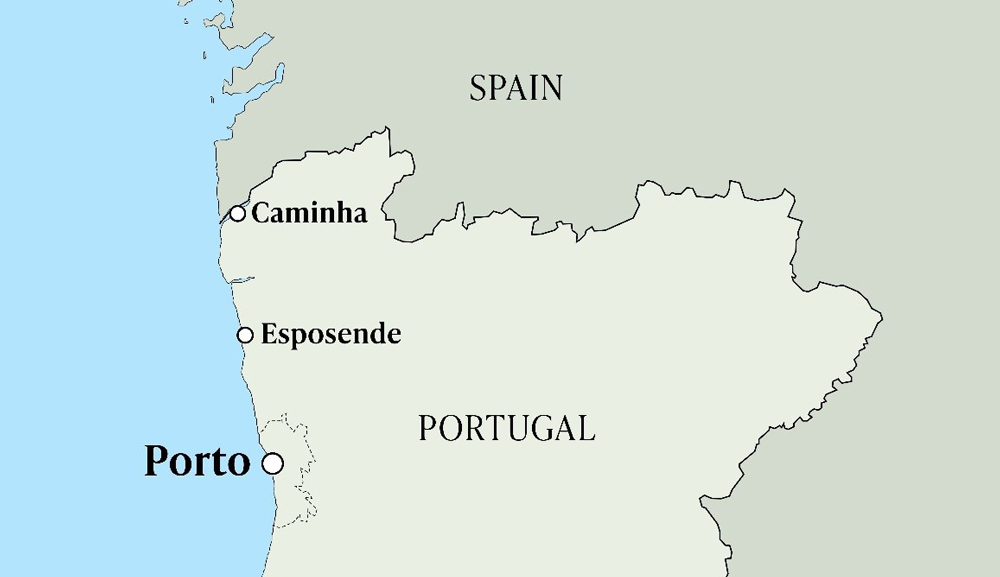
In Caminha, this history is a constant companion.
Walk this town and you’ll see the remnants of its historic town walls…the 15th-century Igreja Matriz de Caminha church…and the 13th-century Torre do Relogio clocktower, which stands watch over the town’s main plaza.
And yet despite all this history, Caminha feels modern and upmarket. This is a town that has undergone a stunning rebirth in the past several decades.
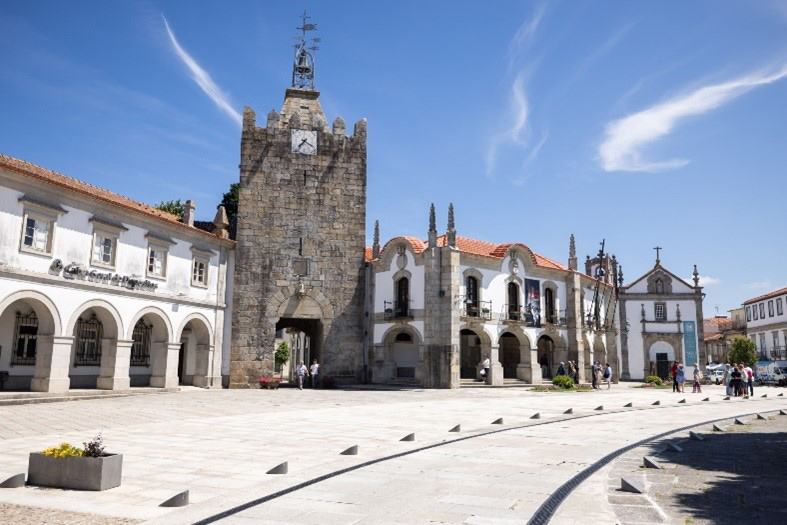
While sipping a coffee in the charming town square, I started chatting to two longtime expats from the U.K. and Ireland.
They pointed out all the buildings in the town square that were derelict as recently a decade or even a few years ago.
Now each of these buildings has been lovingly restored. Today, they host restaurants…art galleries…cafés…boutique hotels…
Caminha is a town on the rise.
A huge part of Caminha’s appeal is the surrounding natural beauty.
On its riverfront, a golden-colored walkway sweeps alongside the banks for a mile or so before turning to reach a lagoon beach that juts out into the river mouth. This beach is interconnected with another on the Atlantic side called Camarido Beach that offers stunning views out to the ocean. Just back from the twin beaches are pine-forested campgrounds. On the opposite side of the river mouth, less than 400 yards away at its nearest point, is Spain.
It’s difficult to imagine a more glorious coastal setting than this.
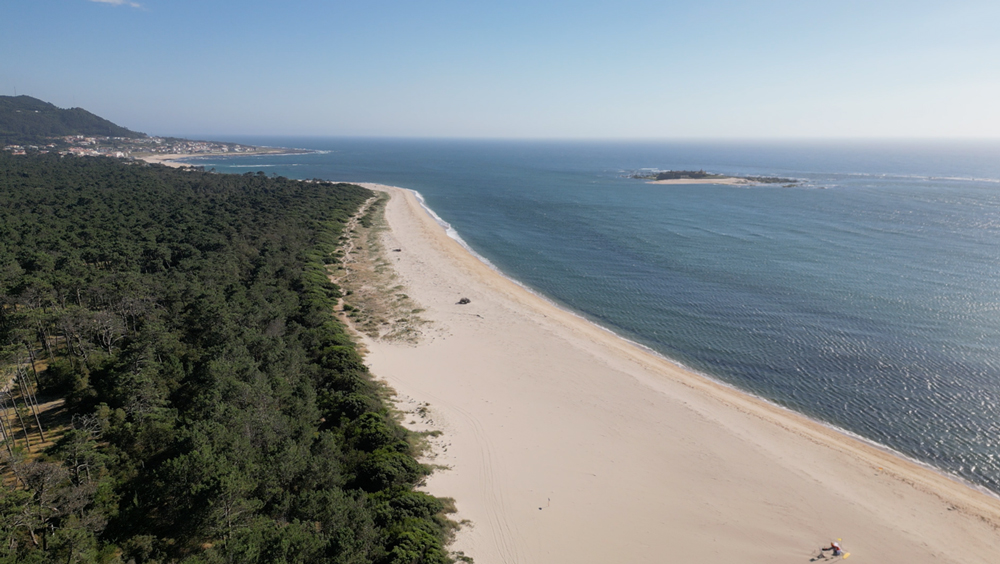
The town of Caminha is well known to our readers. Ronan scouted it last year. I followed up last December, finding it equally impressive.
On this trip, I was excited to return and scout Caminha in the warm June sunshine. It did not disappoint.
The main square, with its long centuries of history, is a stunning place to sit and watch the world go by. Al fresco dining is possible late into the evening. And bathed in sunlight, the beaches and river here glisten and shimmer. Out on the water, wind-surfers leap from Atlantic waves, while fisherman cast lines from bobbing wooden boats. It’s truly idyllic.
Yet, this wildly attractive corner of Portugal continues to be overlooked.
Visiting in June, I’d expected to see scores of tourists wandering the town and lounging on the beaches. But the beaches were blissfully quiet. And for the most part, the only visible visitors in the town itself were the constant stream of hikers passing through.
They were following the pilgrim route of the Portuguese Coastal Camino that leads to Santiago de Compostela in Spain. Some begin in Caminha, many others start farther south in Viana, or even Porto. Irrespective, they are a regular presence in Caminha, as most choose this as the crossing point into Spain, hiring water taxis to take them across the Minho.

There’s evidence word is slowly getting out about Caminha. It’s been appearing more frequently on lists of Portugal’s most attractive towns. And I met the odd visitor there from the U.S. and U.K. But there’s no question Caminha remains under the radar.
Which means the opportunity is still available here…the chance to own homes near the beach in an impossibly picturesque town at prices that are frankly jaw-dropping.
I found small, two-bed apartments listing from €190,000…renovation projects in the historic center from around €175,000…and spacious, modern villas with pools at around €370,000.

This town is on the cusp. Those visitors I encountered from the U.K. and U.S. raved about the town. They’ll tell others. More people will come.
Caminha will be discovered. And that’s an immense opportunity.
Find the right property in Caminha and with a mortgage, you could more than cover the cost of ownership.
In essence you could own a home by the beach in idyllic small-town Portugal, and it wouldn’t cost you a dime. That’s the power of buying ahead.
Viana do Castelo: Northern Portugal’s “Hidden” Beach City
From the Mount of Santa Luzia overlooking the city of Viana do Castelo, you can see everything that makes northern Portugal so awe-inspiring…all in a single frame.
Dominating the hill is the Basílica de Santa Luzia—a towering church whose architectural style is a captivating and eclectic mix of Byzantine, Romanesque, and Gothic influences. In my travels, I’ve encountered more churches, cathedrals, temples, and mausoleums than I can count. Few, if any, rival the majesty of this one.
Then there are the vistas…
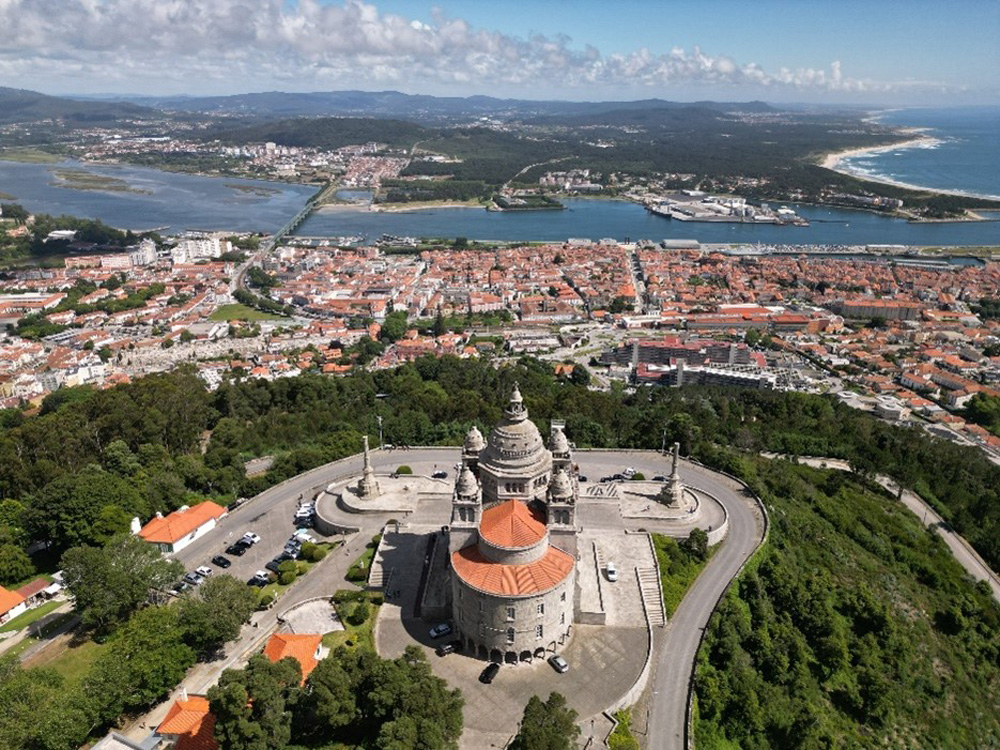
From its elevated position atop the hill, the church offers stunning views of the city, the River Lima, and the Atlantic Ocean.
From above, Viana do Castelo is a collage of glistening white-washed buildings and red-tiled roofs that runs down to a modern waterfront on the north banks of the river mouth.
On the Atlantic shores north and south, long stretches of golden sand nestle beside lush parks and pine forests.
In the waters of the river and ocean, you’ll see wind-surfers, kite-surfers, competitive sailing competitions, water-skiers, kayakers—people engaged in virtually every watersport you can think of.
Ocean…beaches…river…forests…mountains…a stunning Old Town…history and culture…
This northern Portuguese city of Viana do Castelo is one of the most complete destinations I’ve visited.
And yet when I scouted it, there was scarcely anyone there…
To get to the hilltop church, you can take a funicular railway called the Elevador de Santa Luzia. Dating to 1923, the small, cramped train ascends 850 feet in seven minutes.
When my colleague Alan and I took the funicular in June, there was no line. We hopped straight on. And when we got to the top, there were available parking spaces outside the church (you can also drive up).
Granted we were visiting mid-week. But I’d expected throngs of tourists…long lines…bustle and noise… In virtually any other European destination I can think of, an attraction as stunning as this would be mobbed year-round.
Yet, in Viana, as locals simply call it, we found none of this. It was the same in the Old Town. The restaurants were busy, but not crowded. The streets lively, but not packed.
It was all so…civilized. And it demonstrates just how unexplored northern Portugal remains.

Viana do Castelo is the largest city north of Porto and Braga. Though “city” is perhaps a generous way to describe it.

The wider metropolitan area, encompassing nearby commuter towns, has a population of less than 90,000. Within Viana itself, there are just 36,000 people.
This helps explain its charming small-town atmosphere.
Viana was once a hard-working industrial city known for shipbuilding and fishing. These industries remain today, though in reduced form. Ships are still built in Viana. Trawlers still sit along the banks of the river. And more modern industries have come…wind turbine manufacturing is big business here now.
But over the past two and a half decades, the city has been quietly gentrifying…
In 1999, the town’s working riverfront was extended and transformed into a vast new public space called Praca da Liberdade, with parks, restaurants, and exhibition venues. The industrial infrastructure that previously occupied this area was moved to a new purpose-built site on the south bank.
Steps were also taken to restore its walkable Old Town, known for its medieval architecture, elegant squares, and traditional homes and stores with their intricate azulejo tiles and cast-iron balconies.

Walk Viana’s historic center today and it appears pristine…its white-washed buildings filled with upmarket stores and charming restaurants serving cuisine that has a heavy focus on fresh seafood. It’s a stunning, captivating place to go for a stroll, with an inviting café and historic landmark around seemingly every turn.
Then there are the city’s Atlantic beaches…
On the coasts north and south of the river mouth, you’ll find five or six to choose from. The most well known is to the south. Called Cabedelo, it’s a popular surfing and wind-surfing destination, with surf schools and restaurants set just back from the shore amid the small pine forests that dot the area.
From the center of Viana, the beach is a less than 10-minute drive across Ponte Eiffel, or Eiffel Bridge (named for its creator, engineer Gustave Eiffel, who also built the Eiffel Tower in Paris). Alternatively, you can take the small, quaint passenger ferry that leaves from the north bank of the river.
It all adds up to one of the most livable destinations I’ve scouted.

As Viana has become more gentrified, new wealthy residents have been moving here…
While scouting the city, I met up with Joao Malheiro from a local real estate group that operates the agencies Entreportas and Luximos. The latter is an exclusive affiliate of Christie’s, the global luxury real estate brokerage.
Joao took me to see the kinds of properties being developed here with luxury buyers in mind.
In the center of the Old Town, on a pedestrianized street that serves as one of Viana’s main commercial spaces, a developer has converted a grand old historic structure into a luxury condo building comprising 16 homes.
These condos are large, bright, and spacious. We toured one spanning two floors across 1,400 square feet, with original historic features from the building integrated into the design of the condo. It was stunning, but the price tag was significant. It’s on the market for a whopping €690,000.
You can view a walkthrough I completed of the property below…
Behind the building on the same plot, there were also a small number of new villas, built in a modernist style. These were larger than the historic condos, at more than 1,800 square feet spread across three floors. These were on the market for €590,000. (You can contact Joao and his colleagues about these and other properties on the market in Viana here. Note: we haven’t done due diligence on him or his agency.)
Here’s a walkthrough of one of those…
High-end luxury residential projects like this are increasingly common in Viana…
On the outskirts of town, along the riverbank, new waterfront condo developments have been popping up. These are vast homes, with price tags that can run well over a million euros.
Not that you need vast sums like this to own in Viana.
In fact, you can own here for a tiny fraction of this…
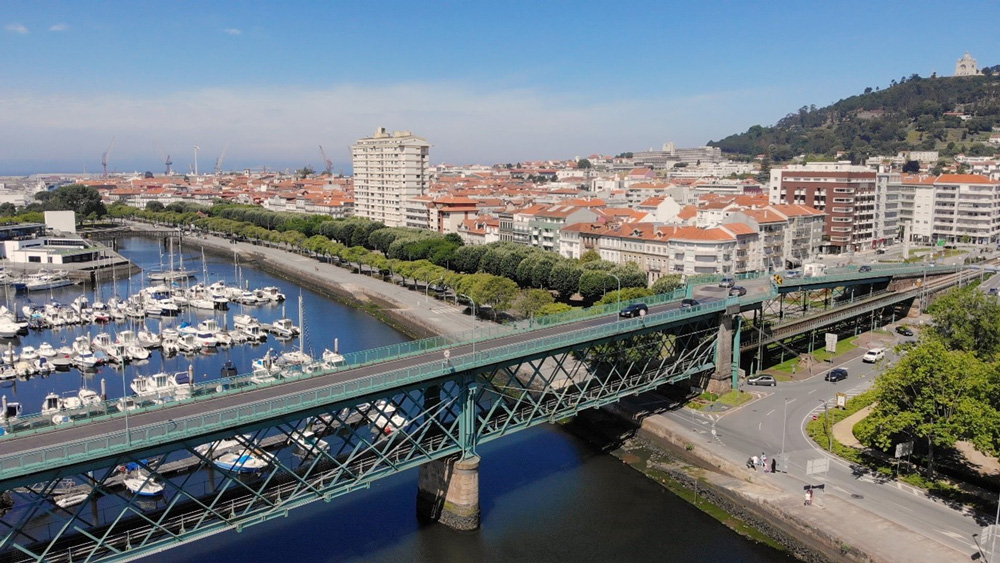
This is a pattern we’ve seen play out time and again in emerging destinations around the world. The wealthy are often the first to discover an inherently beautiful destination.
They come for the natural beauty, the livability, and to escape the madding crowds. As their wealth pours in, others follow. But there’s a lag…
Viana, like many of the destinations I saw in northern Portugal, now exists in that incredible sweet spot. The wealthy have discovered this city, but it remains virtually unknown to the millions of foreign tourists, expats, and second home owners who flock to Portugal each year.
Here’s what undiscovered looks like…
Last year, Viana saw a 22% spike in visitor numbers. But even at that, it welcomed just over 185,000 people, and many of these were domestic tourists or visitors from Spain, which is less than an hour’s drive to the north.
According to the official figures, just 5,613 Americans visited Viana in 2023. In fact, not a single country bar Spain and Germany sent more than 10,000 tourists to Viana in 2023.
This city continues to fly firmly under the radar…and that means you can still find incredible value real estate here.
Homes in the Old Town tend to be smaller due to the nature of the historic buildings, but if you don’t mind a reduced living space you’ll find options right in the very center.
I found small apartments, of around 720 square feet, in good condition, listing for €170,000. There were also larger, modern condos on the market in the €300,000 to €350,000 range.
Consider the opportunity here. If you bought a property for €170,000 and got a 30-year mortgage of 70% at 3% interest (mortgages like this are available to non-resident foreign buyers in Portugal), you can own here for less than €500 per month.

Head out of the Old Town and you’ll find ever greater value.
Across the river, on the south bank, there are river-view residential communities that are just a few minutes’ walk from the beach. Traditionally, this area, known as Darque, was considered less desirable. It’s across the water from the Old Town and the government built social housing here. But as Viana has been gentrifying, and as word has spread about the incredible beaches on the coast south of the river mouth, Darque has been coming into its own.
Prices, though, haven’t caught up to this reality. I found a modernized, four-bed condo of 1,730 square feet with views of the river listed for €235,000.
There’s another play to consider here in Viana…own on the coast directly north of the city.
The small beach towns of Afife, Carreco and Areosa are all less than 15 to 20 minutes’ drive from the heart of Viana’s Old Town. But prices there can be shockingly affordable.
You’ll find modern, three-bed condos for around €200,000 or less.
And you’ll also find large fixer-upper rural homes set up in the hills, but less than 15 minutes’ drive from the Old Town, in this price range.
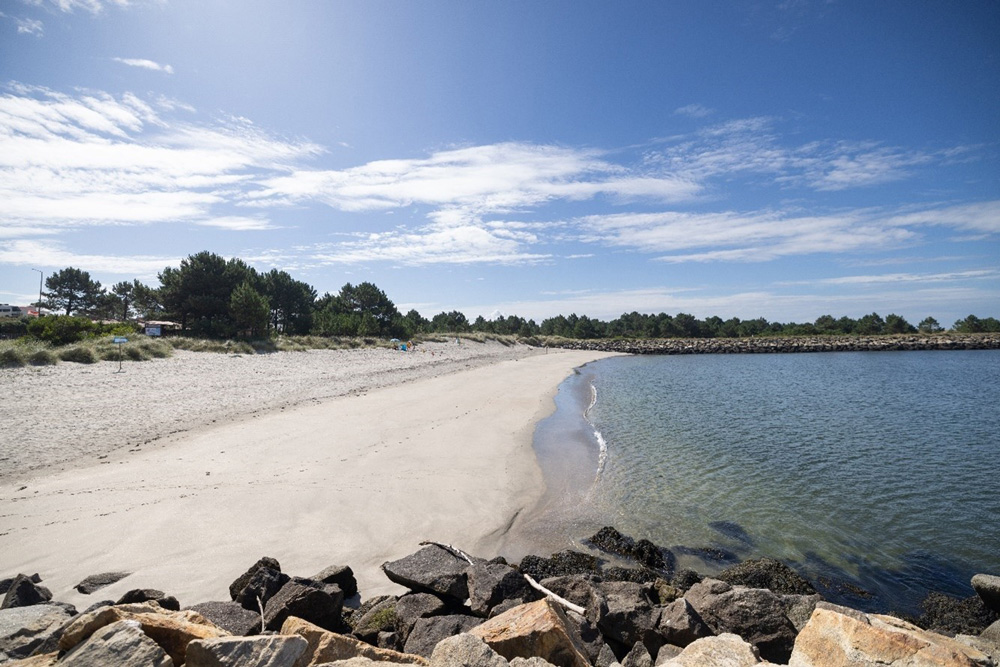
Let’s talk rental income in Viana…
The agents I spoke to here say there’s a shortage of homes for rent on the long-term market within the city. When I checked a major listings site for long-term rentals, I found just 13 available in the Old Town.
According to the agents from Entreportas, one-beds in good condition in the historic center rent for an average of €880 per month long term. Two-beds for €1,250. And luxury condos like those I toured for €1,500 and up. Those figures chime with listings I’ve seen online.
This means yields here are reasonable. Say you bought a one-bed for €170,000 and rented it long-term for €880, then your gross annual yield is 6.2%.
And here’s the thing about those yields…
They are likely to rise.
In Viana, you’d be buying ahead of a rise in new arrivals. More people will come to this city—to visit…to work remotely…to retire…
The offering here is too strong…the city too livable. The world hasn’t discovered Viana yet, but it will.
Esposende: True Beachfront Living in a Wealthy Enclave
Alan and I didn’t intend to scout the town of Esposende…we just went to look at some windmills.
We were heading north, from Porto airport on our way to Viana. But we were taking our time…driving the coastal road, not the highways…exploring…digging deep…
The first destination we aimed for was the coastal village of Apulia.
About 35 minutes’ drive from Porto, Apulia has an outsized reputation thanks to some quirky bits of architecture. On sand dunes overlooking its coast are historic windmills and storehouses made of granite and schist.
Built in the early 19th century, these mills were once used to grind and store the maize grown in this region. Now some have been transformed into second homes or vacation rentals, such as this one. (Later, in the town of Caminha, Alan and I bumped into a group of British tourists who’d stayed at one…and they loved it!)

The windmills brought us to Apulia, and they’re a sight to behold, but the village itself was a tad gray and unremarkable. So, we continued on toward Viana…
As we pushed north, the complexion of the area quickly started to change. More hotels…more residential developments…more expansive villas looking out over the coast…
We were approaching the wealthy enclave of Esposende.
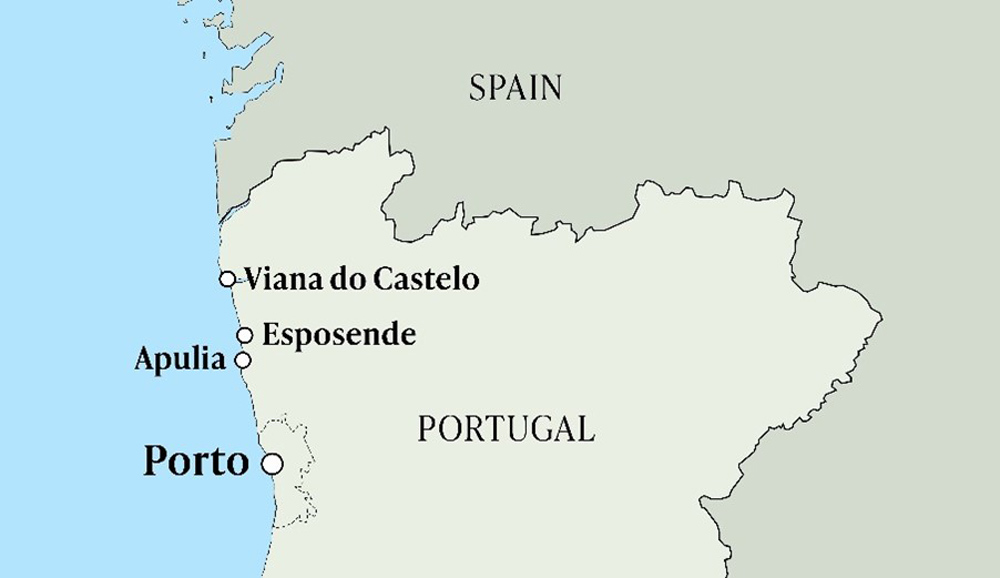
Esposende is a historic coastal town of around 10,000 people that sits at the mouth of the Cavado River, on its northern bank.
Along the riverside runs a wide palm tree-lined boulevard with a cycle track that leads to Esposende’s stunning wind-swept Atlantic beach, backed by low dunes and overlooked by the 17th century Fort of São João Baptista and the towering red lighthouse that sits beside it.
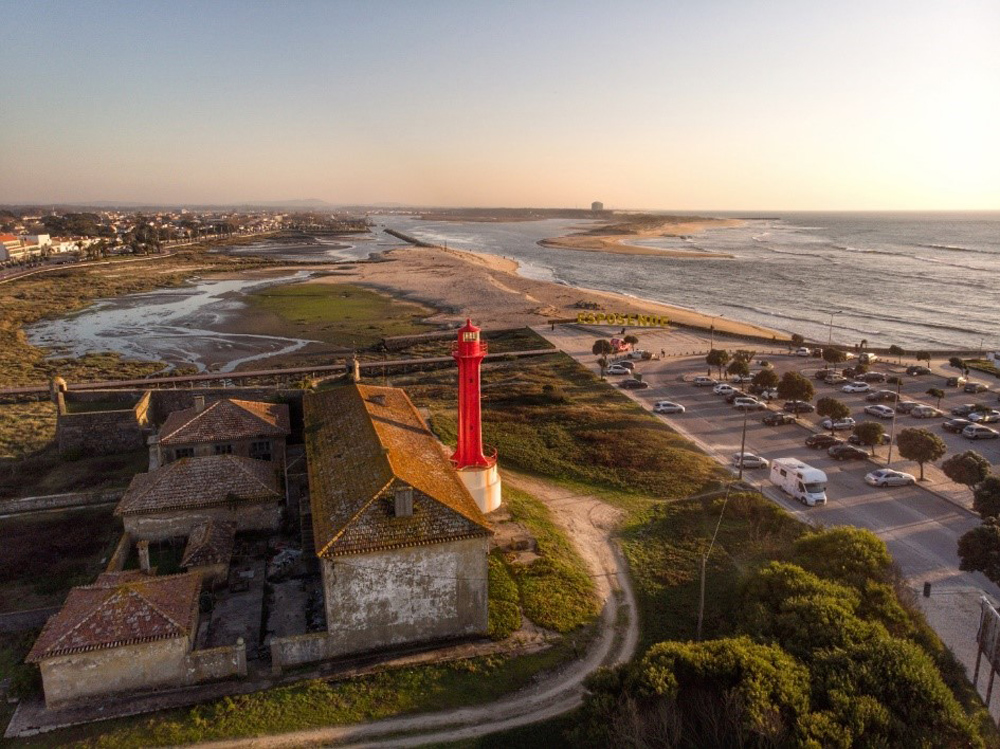
The geography of Esposende is intriguing. A long strip of sand, now a protected landscape, juts out into the river mouth, leaving only the tiniest sliver of space for the river to flow into the ocean.
It’s an incredible sight…
Standing on the riverfront promenade in the center of Esposende, beneath the shade of its large palm trees, you’ll see a spectacular view across the river, over this protected sandy region, out to the Atlantic.
The view is even better from the town’s Atlantic soft-sand golden beach…
Located less than half a mile north of the town center, it looks south to the protected landscape and west out to the glistening blue waters of the Atlantic.
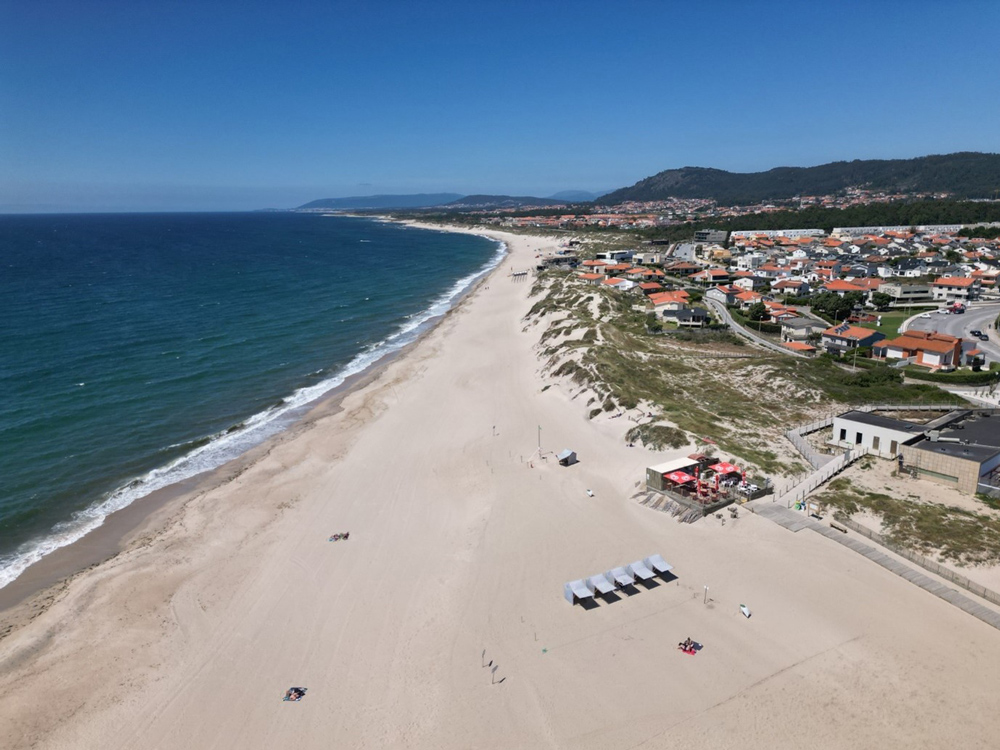
Esposende shares certain similarities with Viana… it’s a former fishing hub, and a place that attracts watersports enthusiasts. Surfers, wind-surfers, and kite surfers frequent its Atlantic beaches. Sunbathers too.
Esposende, though, is much smaller and more intimate than larger Viana.
The historic center stretches no more than a few blocks in each direction. Nestled within, you’ll find charming plazas, fronted by historic buildings like the town hall, expanded from an original structure dating to the late 16th century.
At the center of it all, on Esposende’s main boulevard, is the Church of the Misericordia, whose origins are just as old.

Despite its long history, however, Esposende today feels modern and affluent…a function of its wide, riverside boulevard and the numerous large villas surrounding the town center.
On the road into and out of town you’ll see expansive detached river- and ocean-view houses—some built in a traditional Portuguese-style with verandas and red roof tiles…others modern, with floor-to-ceiling windows, flat roofs, and large terraces.
These villas sell for vast sums…even millions of dollars.
Esposende is where many of the wealthy of Braga and Porto choose to own coastal properties. The town is no more than 40 minutes’ drive from either city. Yet, as in Viana, and virtually everywhere else along this coast, Esposende offers exceptional value in the middle tier of the market.

Within the town center, you’ll find two-beds for less than €200,000. Three-bed villas of around 2,000 square feet list for €300,000 to €350,000.
Look to the south bank of the river and you’ll find something even more intriguing…
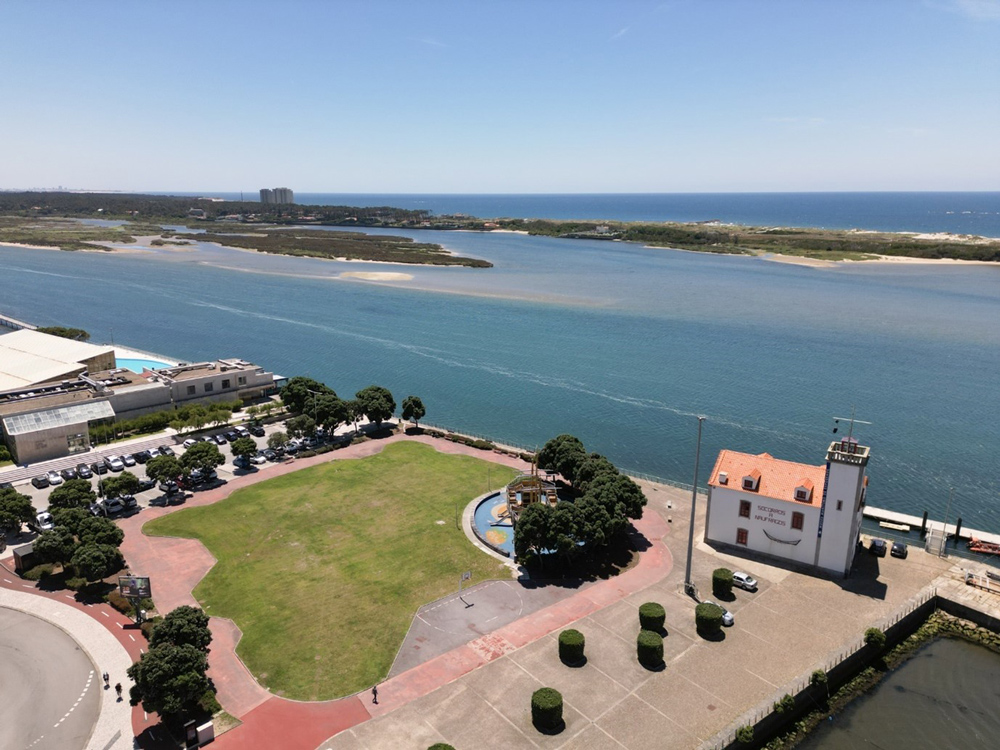
A 10-minute drive away from the quaint, compact town center, is the beach of Ofir. This is among the most stunning I’ve seen in northern Portugal, a sweeping stretch of pristine golden sand that’s popular with surfers and swimmers alike.
The beach sits within the North Coast Protected Landscape that’s visible from the town and stretches out into the mouth of the Cavado River. Walk along the dunes and boardwalks here and you’ll get incredible views of the Atlantic Ocean on one side and Esposende on the other.

Overlooking Ofir beach are three towering condo developments built between the late 1970s and mid-1980s. These condos literally hang over the beach…residents are mere steps away from the sand of Ofir and they have private access.
Today, developers in Portugal are no longer permitted to build this close to the coastline, but these developments are grandfathered in.
I found a one-bed, ocean-view condo in this community listed for just €225,000. I immediately reached out to the agent in Esposende responsible for the listing. He told me that condo had already been reserved, but he offered to show me two other listings he had in the buildings. These were for larger, three-bed, two-bath units spanning around 1,300 square feet.
One was pristine, like new, with immaculate modern finishes and terraces offering jaw-dropping views of the ocean sitting off every room, bar the bathrooms. It was listed at €459,000.
The other was a touch more dated and questionably decorated. The current owner has painted the home in dark blues that feel out of touch with the oceanic setting. According to the agent, the home was on the market for €450,000, but an offer of €410,000 could be enough.
Looking online, I also found another three-bed in these buildings listing for €375,000. And I found a one-bed there on the market for €250,000.
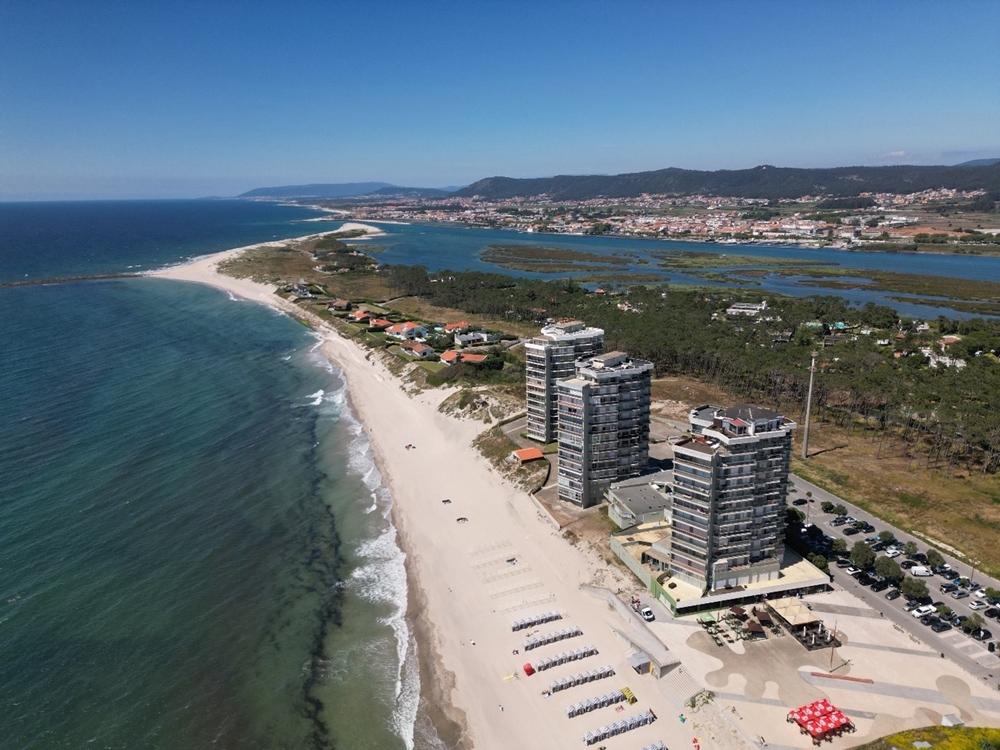
There’s a caveat with these condos…
The buildings reflect their age. The communal spaces are weary, the building exteriors are an unappealing gray-green, and the facades are decaying in places from decades of being battered by the salty sea air. Remedial work is needed and planned on Tower A, where the questionably decorated condo I toured is located. Owners are looking at a bill of €15,000 for the work.
All that said, consider this…
Unless the law changes, and that seems highly unlikely, nothing will ever be built this close to the beach again. Not on this stretch of coast…not anywhere in Portugal. The limited number of frontline beachfront communities that exist are all there will ever be.
And one like this—overlooking a beach of the quality and popularity of Ofir, and minutes from the wealthy enclave of Esposende—feels like a true find, especially when you can own here from €250,000. If you got a 30-year mortgage of 70% with 3% interest (available to non-resident foreign buyers in Portugal), that’s a monthly repayment of only around €734 per month. Mind-blowing.
Braga: The “Next Porto”
Immediately across the single-lane street from my Airbnb in the historic city of Braga—in an old stone terraced house off one of the city’s main plazas—was a trendy tapas bar that hosted techno nights. Next door was a store selling priests’ vestments and two-foot statues of the Virgin Mary.
Braga in a nutshell…

This city, about 45 minutes’ drive northeast of Porto, is a place of joyous contradictions…
It’s one of Portugal’s oldest cities, founded more than 2,000 years ago in the Roman era as Bracara Augusta. It’s also a major religious center, famed for its dozens of churches in Romanesque, baroque, and neoclassical architectural styles. Wander its circular, mostly pedestrianized historic center and you’ll rarely walk down a cobblestoned street or alley without ending up in a plaza…looking at a church.
And yet, despite this abundance of history and religious traditions, Braga feels youthful and vibrant. This is a university town and major economic center. Around 40% of its population is under 30. Chic bars and restaurants occupy many of its centuries-old buildings.
Factor in its Mediterranean climate and its largely flat Old Town, and the result is a place that’s both livable and distinct…
This combination makes it extremely appealing for retirees, full-time remote workers, and tourists on city breaks who want to escape the crowds that descend on Porto and Lisbon.

While in Braga, I met an American expat who moved to the city from California via a stint in Costa Rica—part of an influx of foreign residents in recent years. She and her husband wanted to be closer to family in Germany, and settled on Braga after googling Portugal’s most livable cities. She couldn’t wait to wax lyrical about the laidback lifestyle and hiking trails in the forested hills just outside the city.
Which brings us to the geography…
Braga exists in a sort of in between. It’s 30 minutes’ drive from Atlantic beaches to the west…and about 45 minutes from the mountainous Peneda-Geres National Park on Portugal’s border with Spain in the east. The upshot is, if you’re willing to hop on a bus or in a car, everything is on your doorstep.

Braga is sometimes called “the next Porto.” The implication being that the city is the next target in Portugal’s relentless wave of gentrification.
The characterization is fair, if overly simplistic. Gentrification is certainly coming to this city, as it came to Lisbon and Porto. Cranes hover in the skies. And just like Porto, you’ll find buildings undergoing restoration work on virtually every street in its historic center. But the pace in Braga is calmer and gentler.
That’s a positive in terms of livability, but it means limited supply to meet significant demand for real estate in the historic center.
Still, prices are notably cheaper than in nearby Porto.

You’ll find small, new studios in Braga’s historic center in the sub-€200,000 range.
Something more spacious will run in the mid- to high-€200,000s or above.
As Ronan previously identified in Porto, it feels like a good opportunity here would be to buy a historic home and convert it into one or more short-term rentals or several apartments.
However, the issue with this strategy is there are so few of these historic buildings on the market. I saw virtually none during my scouting trip.
That feels strange, since there are still plenty of buildings around the historic center in significant need of repair. It feels likely that investors have tracked the trends in Porto and Lisbon and are holding in anticipation of Braga’s continued growth.
Ponte de Lima: “Portugal’s Oldest Town”
Sometimes when you’ve got boots on the ground, you hear whispers about an emerging destination.
That same destination keeps popping up again and again in conversations with investors, developers, real estate agents, tourists, expats…
In my experience, when this happens, it pays to go investigate. The town I kept hearing about was called Ponte de Lima. And boy, was it worth scouting…

Ponte de Lima is often referred to as the oldest vila (chartered town) in Portugal, with an official founding date in 1125.
Though in reality, it’s much older still.
Sitting on the south bank of the River Lima, the town was a significant Roman settlement.
It later become a fixture on the pilgrim road from Braga to Santiago de Compostela and Lugo in southwestern Spain. Today, it’s still part of the Portuguese Camino Central route, a pilgrim trail that remains popular with hikers.
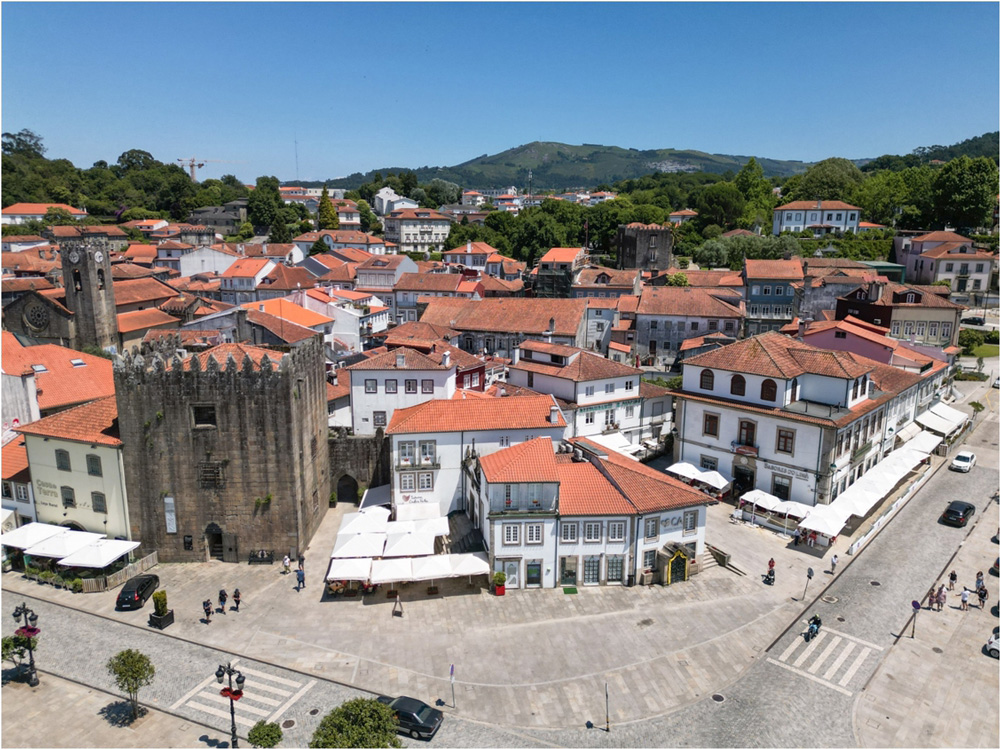
Ponte de Lima has been a major river crossing since the Romans built the town’s bridge in 1 AD.
The bridge you’ll see in the town today is partly the original constructed by the Romans, though it was restored and extended in the medieval period.
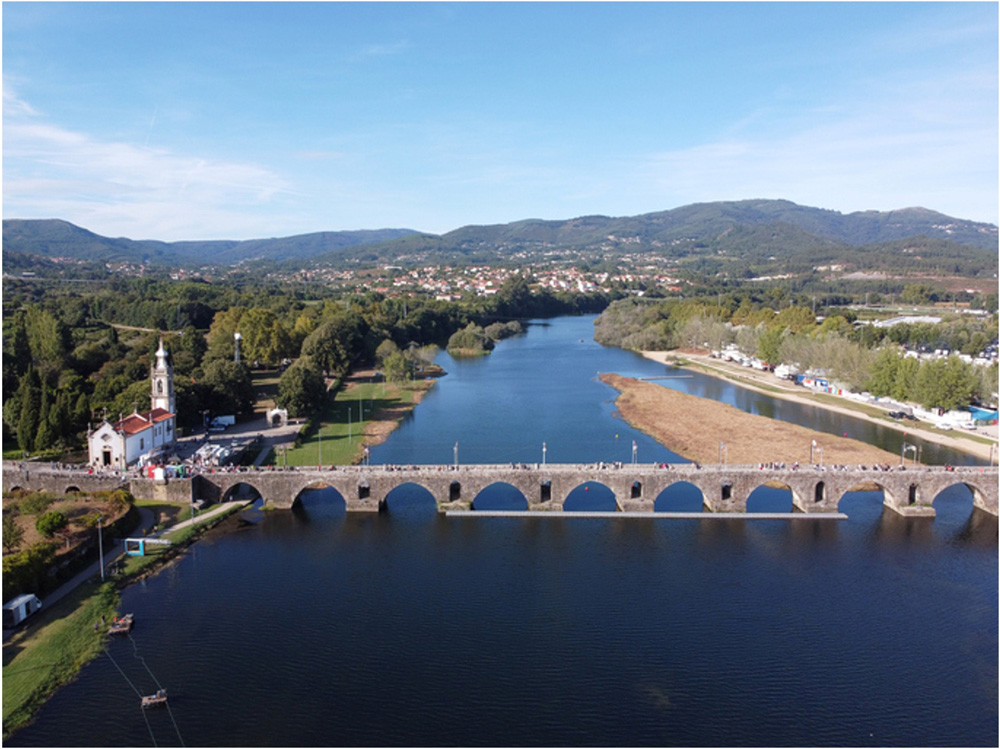
Remnants of Ponte de Lima’s medieval past are scattered throughout the town.
In fact, if you look carefully at the walls of the some of those medieval buildings, you’ll see the “signatures” of the townspeople.
Back then, education was reserved for ecclesiastics…very few lay people could read or write. So when they were building structures, stonemasons marked the stones they laid so they could collect their wages. You can still see their markings today on the bridge, towers, and on the town’s cathedral.

In recent decades, Ponte de Lima has gained a reputation as one of the best-preserved towns in northern Portugal. It has started attracting tourists, who come to walk amid its gleaming whitewashed buildings with their signature terracotta-red tile roofs.
Today, many of the buildings along the riverfront and circling its plazas host upmarket cafés, restaurants, and stores.
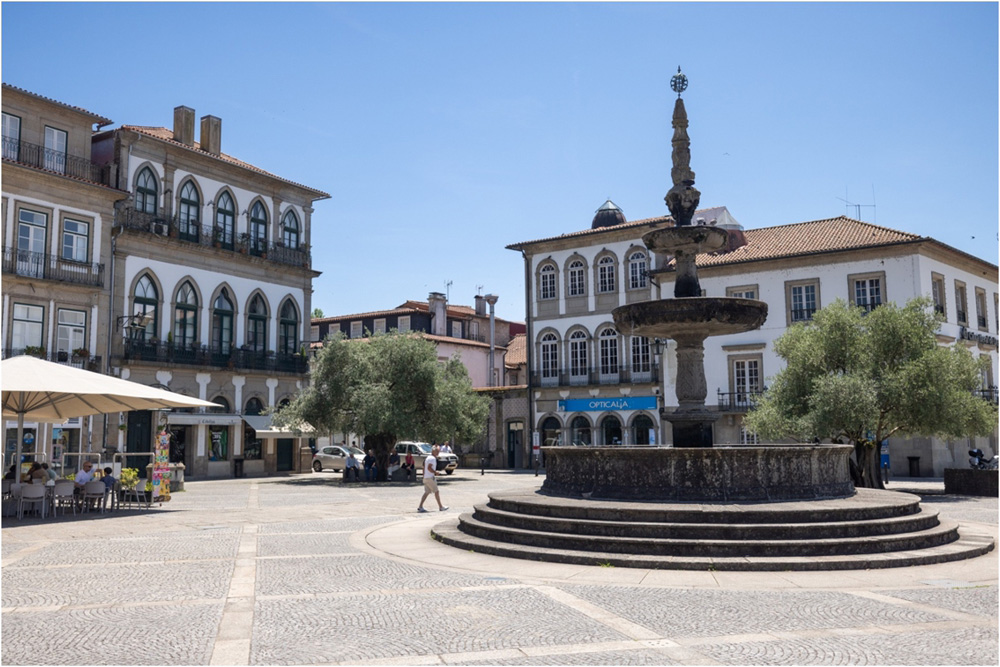
Despite its small size, Ponte de Lima is a buzzing little town with lots going on. Every second Sunday, in a leafy park along the riverfront, the town hosts a market.
On the day Alan and I visited, vendors were selling all manner of ceramics, paintings, embroidery, and woodcrafts.

Each summer, the town also hosts the Festival Internacional de Jardins (International Garden Festival).
Running from the end of May through to October 31, the festival showcases 12 different gardens (the designs are chosen from a mix of national and international floral specialists) filled with flowerbeds, fruit trees, and a huge variety of plants.
There’s also a leisure area, a playground, and swimming pools at the festival site.
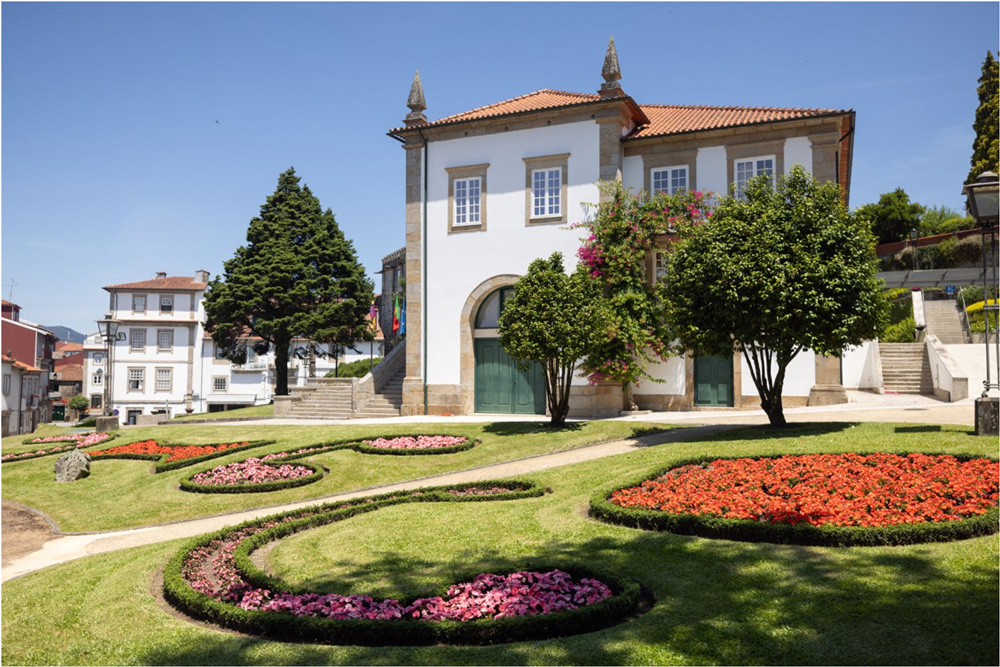
Ponte de Lima is also a center for the production of Portugal’s famous vinho verde (“green wine”). Usually light and fruity, this wine uses young grapes (three to six months) and comes in red, white and rosé varieties.
You’ll find plenty of restaurants and cafés around town to sample a glass or two.
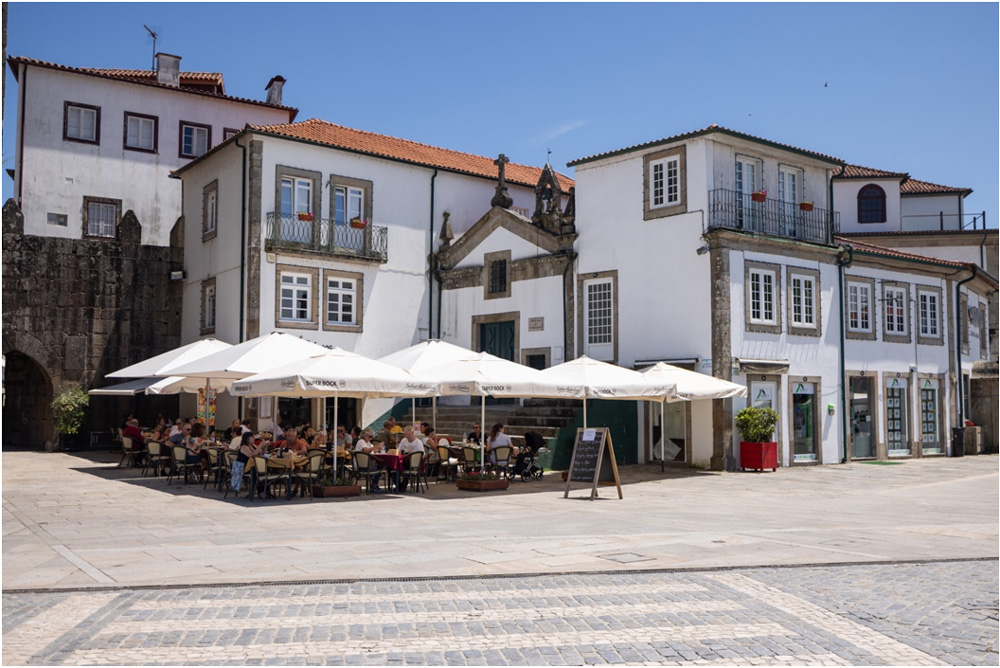
Although it now features regularly on lists of Portugal’s most picturesque towns, Ponte de Lima, like so many other regions in the north, continues to fly under the radar.
I was astonished by the beauty of the town but even more astonished when I saw the real estate prices here. Dated three-bed condos in old buildings list for €120,000 to €150,000.
New-build one-bed condos in the center of the town are on the market for €175,000. Two beds in new developments list for €200,000…sometimes even less.
With those kinds of prices and the livability of this town, more people will come here. Believe the buzz. Ponte de Lima is a town that’s now firmly on our radar.
Note: You can read the original, unabridged version of the December 2023 scouting report here. This includes information on Caminha, Braga, and Porto’s sister city to the south, Vila Nova de Gaia.
And you can read the original, unabridged version of the June 2024 scouting report here. This covers Viana do Castelo, Esposende, and Caminha.